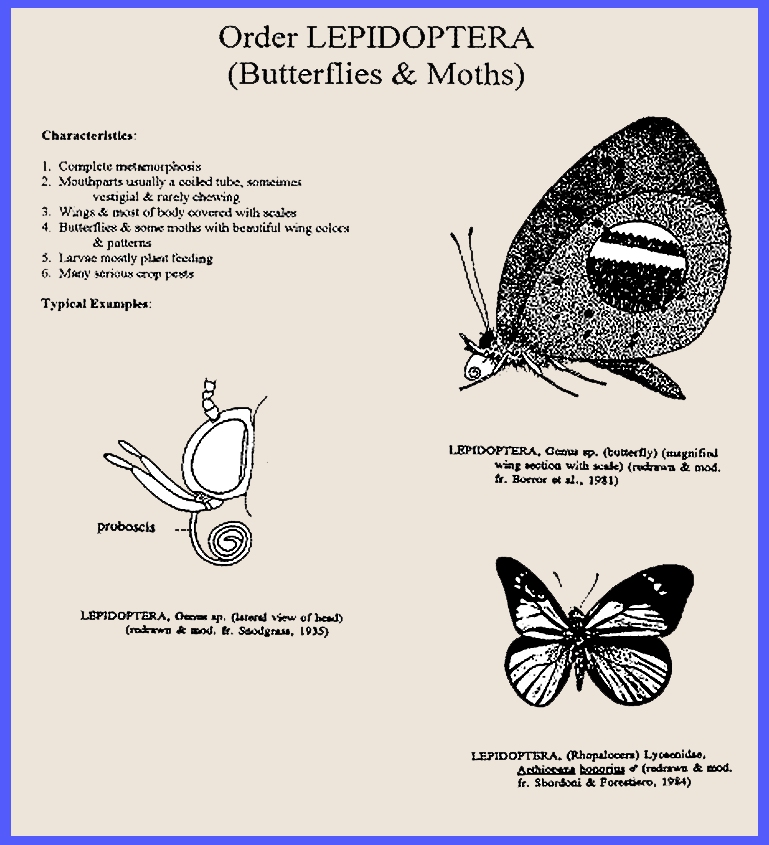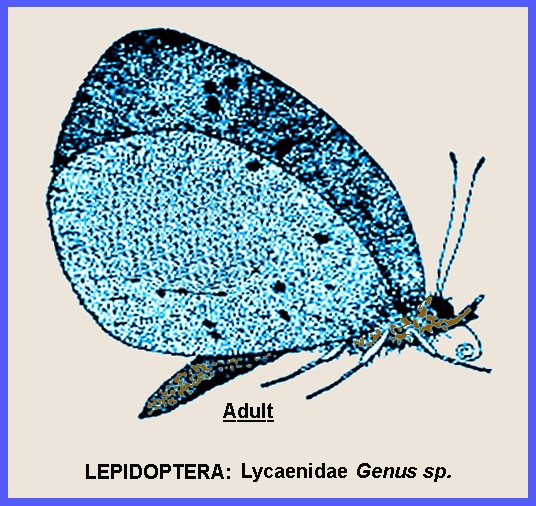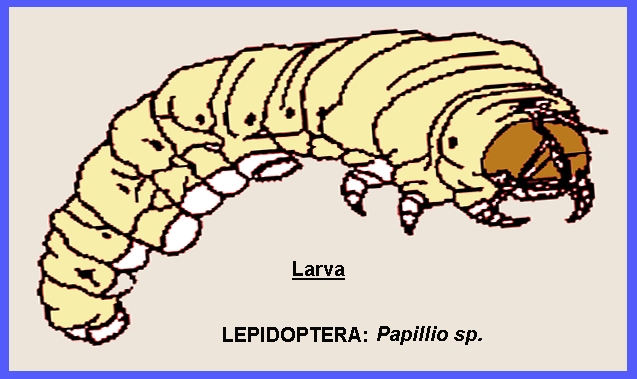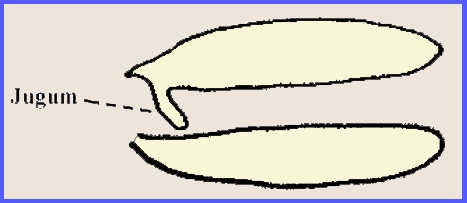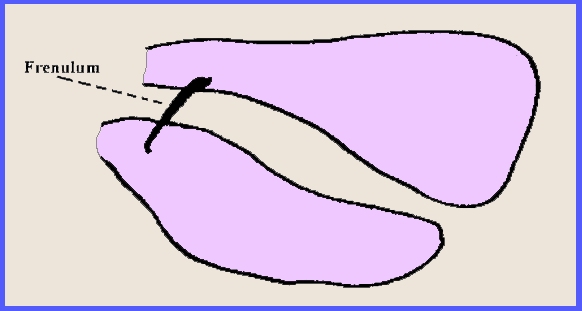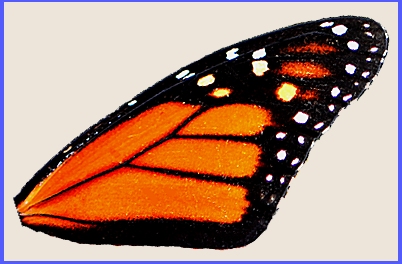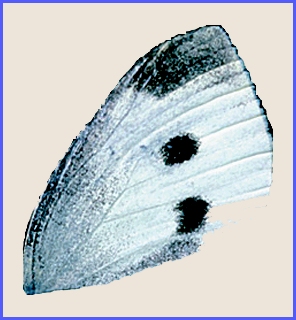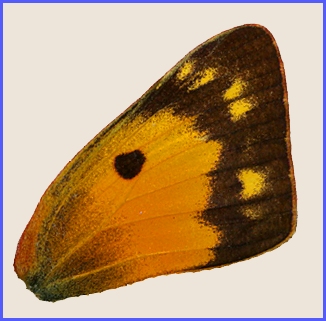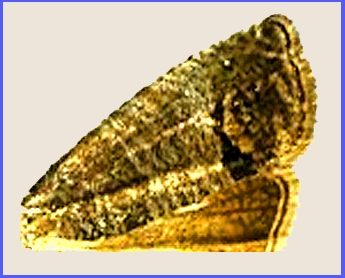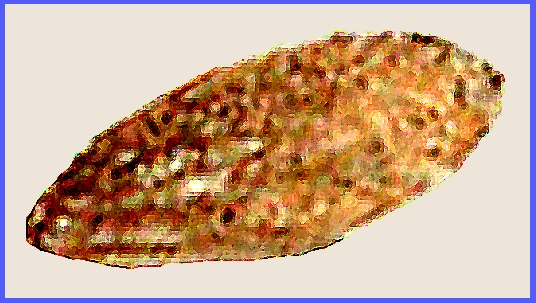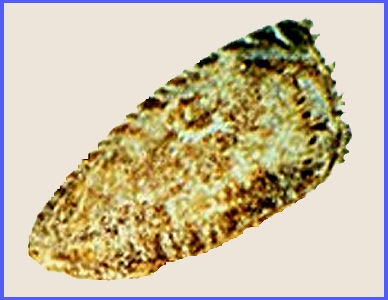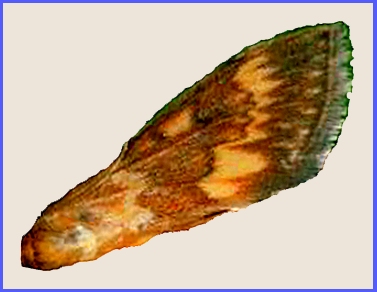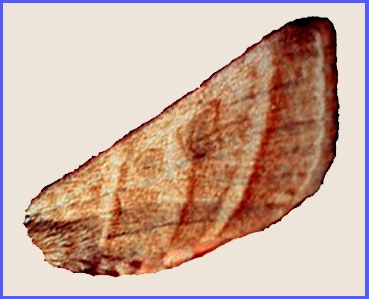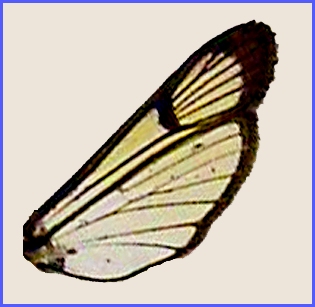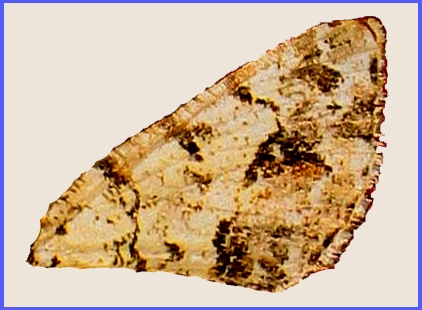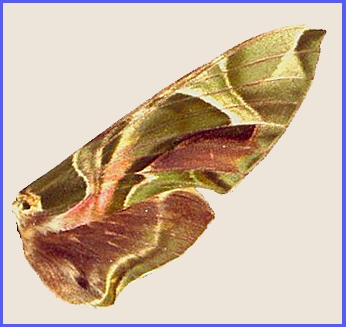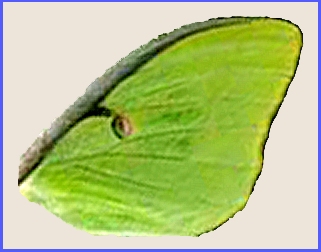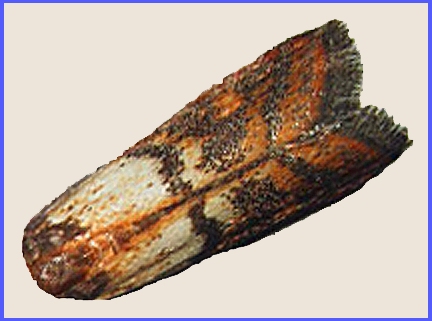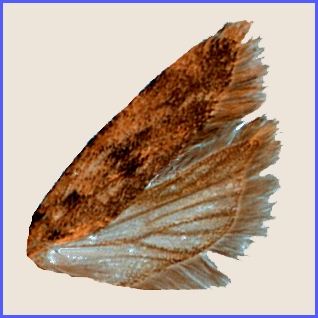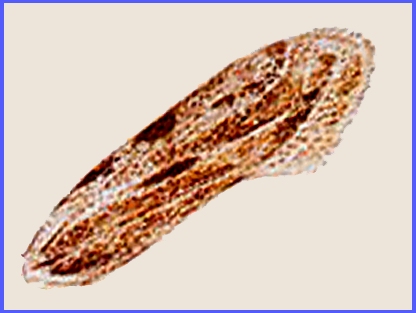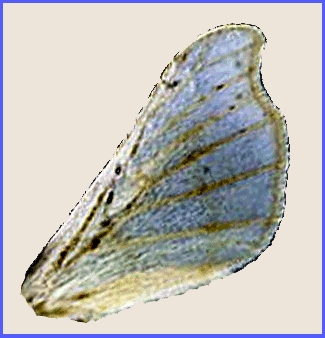File:
<lepidoptera.htm> < (Entomology),
(Invertebrates), (General Index)> <Invertebrate
Bibliography> <Glossary> <Site Description> < Home>
|
Entomology: LEPIDOPTERA
1 Kingdom: Animalia, Phylum: Arthropoda Subphylum: Hexapoda: Class: Insecta: Order: Lepidoptera (Contact) Please CLICK on underlined
categories to view and on included illustrations to enlarge: Depress
Ctrl/F to search for subject matter:
General Summary of
Lepidoptera
In the Lepidoptera only a sucking proboscis
formed by the maxillae usually represents the mouthparts of the adult. There are two pairs of membranous wings
that are covered with flatten scales, as also is the body. Metamorphosis is complete. The larvae are eruciform with chewing
mouthparts, with three pairs of legs on the thorax and often five pairs of
prolegs on the abdomen. The pupa is
obtect, either enclosed in a cocoon or an earthen case, or free (See Glossary
for terminology). The adults live on flower nectar
that they absorb with a specialized proboscis that has been made from the
elongated galeae of the maxillae, each being grooved along its inner face and
locked to its neighbor. The laciniae
are atrophied and the maxillary palp is regularly greatly reduced. The
mandibles are mostly functionless, being fused to the head capsule, and a
triangular plate and a pair of large three-jointed palps arethe labium.
Developed
independently in the order.
The thorax has three pairs of
legs, and the abdomen five pairs of prolegs on segment 3-6 and 10. Such
prolegs are different from the usual insect limbs, being conical and
retractile and with hooks on the apex.
In many families there are less than five pairs of prolegs.
Most Lepidoptera are harmful in
the larval stage, few plants being free from their attacks, and some of the
world's most serious insect pests, such as the cotton-boll worm, Platyhedra
gossypiella, and the gypsy moth, Porthetria dispar, are included
in this order. However, some caterpillars have been used as agents in the
destruction of invaded cacti in Australia (see ch-87.htm). Taxonomic Groups
Hawkmoths
(Sphingidae) are large, strongly built
moths whose fore wings are much larger than the hind ones. A further feature
is the obliquity of the outer margin of the wings. The proboscis is long and
the antennae, which are thick, end in a hooked tip. Their phytophagous larvae
have five pairs of prolegs and usually bear an upturned spine or process on
the back of the last segment. Of slender build are the geometers
(Geometridae). They are weak in flight
and a wing-coupling mechanism is not always present. Some species, e.g. Cheimatobia,
the winter-moth, are wingless as females. The family gets its name from
the fact that in most of the larvae prolegs are borne by the 6th and 10th
segments of the abdomen only. Such larvae, therefore, walk by looping the
body, bringing the hind segments near to the thoracic and so appear to be
measuring distances along the surface walked upon.
------------------------------------------ Lepidopteran
Wing.
-- A jugum
is a fingerlike lobe on the forewing that
functions to hook the wings together.
It is found in the more primitive Lepidoptera. A frenulum
exists as a stout bristle
in the male or a bundle of bristles in the female. This is the more advanced character. Scales are present on the wings,
which may be of various shapes and often overlap. This arrangement produces colorations. Mouthparts. -- Adult Lepidoptera
possess sucking mouthparts, which appear in the form of a coil. In some species the mouthparts are
nonfunctional or reduced. Also,
rasping spines may be present on the maxillae. The Larvae. -- The larvae may possess
prolegs on the 3-6 and 10th abdominal segments. These are fleshy outgrowths of the abdomen. They do not have the characteristic joints
of the thoracic legs, but they are movable and are equipped with tiny hooks
or crochets on
the apex. When the number of prolegs
is reduced, the crochets may remain as remnants in their place. The Pupae. -- The pupae are obtect
and may form a girdle, or a cremaster for suspension. They may also be enclosed in a silken
cocoon. Moth vs. Butterfly Characteristics. -- According to the
pattern and color of adults, moths are mostly drab while butterflies are more
colorful. Butterflies also have
clubbed antennae while moths have filamentous or setaceous or plumose
antennae. Butterflies are active in
daytime while moths are usually active in twilight or at nighttime. At rest butterflies hold their wings
vertically while moths do so horizontally. ------------------------------------------ Common
Families of Butterflies The following discussion includes
only the most common or important families of Lepidoptera. For greater detail
please refer to Borror et al. (1989),
and for an expanded treatment of Lepidoptera taxonomy with 125 families noted
please see <125
Families>. The front wings of
Lepidoptera males are often diagnostic, enabling a quick means of
identification at least to the family level.
The following discussion shows examples of such wings as
representative of the family. Among the common
butterflies are the Papilionidae or
swallowtail butterflies where an osmatrium is present in the larvae. The Nymphalidae are often observed but
many rare forms are included. The
Subfamily Danainae includes the milkweed or
monarch butterfly whose larvae develop on milkweed. This is one of the few insects that demonstrate migratory
behavior. The Pieridae
includes
the cabbage butterfly, Pieris rapae (L.), where the eggs hatch
into greenish larvae. They attack the
foliage of any cruciferous plant.
There may be 3-6 generations per year. Insecticidal means of control has been required to contain this
pest. Another species, the alfalfa
butterfly,
Colias
eurytheme Boisduval, which is native to North America is a direct feeder on alfalfa
and related crops. Control has
involved the use of insecticides, insect-attacking viruses and early harvest. ------------------------------------------ CLICK on the
following links for more information <Habits>;
<Adults> & <Juveniles> The moths contain most economically important
species. The Olethreutidae has the codling moth
or apple worm, Carpocapsa
(Cydia) pomonella L., with a worldwide distribution. Larvae feed on all pomaceous fruits such
as apples and pears, but only the fruit is attacked. The eggs are laid during the blossoming period or on or
near the developing fruit. The eggs
hatch in about two weeks and the larvae are pink in color. Attack by the first generation causes
fruit to drop, while the second generation produces the wormy fruit. Pupation
occurs in springtime. Overwintering
is as larvae in a cocoon. There are
2-3 generations a year and the adult is only about 1.4 cm. long. Control has involved culling fruit out of an orchard
after harvest and the application of insecticides. Of special interest is the complete absence of this insect in
certain geographic areas of western North America, even though host trees are
being grown there. There have been no
codling moths found in the Owens Valley of Central California. Tortricidae -- <Habits>;
<Adults>
& <Juveniles> --
includes the Mexican jumping bean moth, Lydia
saltitans
(Westwood),
and various forest caterpillars that cause considerable damage. The wing is notched at the tip. The oriental
fruit moth,
Grapholitha
molesta (Busck) is another serious pest in
the family. It attacks the fruit of
peach trees primarily, the injury being similar to that of the peach twig
borer. The larvae are pink in color and
feed close to the pit of peach.
However, other kinds of fruit may also be attacked. Damage is most severe in humid southern
regions of North America. ------------------------------------------ Pyraustidae -- <Habits>;
<Adults>
& <Juveniles> --
includes the European corn borer, Ostrinia
nubilalis
(Hubner),
which was introduced to North America from Europe in 1917 in broomcorn. At least two strains have since spread all
over the North American continent.
Tremendous damage to maize occurs, as the corn stalk lodges so that
mechanical harvesters cannot function and the maize ears often fall. Borer larvae feed on the leaves and surface of maize
after which they burrow into the stalk thereby weakening it. This borer overwinters as larvae in maize
stalks and ears in the diapause stage.
One female can lay over 500 eggs. Control has involved the destruction of maize stubble,
late planting, resistant maize varieties, crop rotation and the applications
of insecticides. The addition of the
toxin gene of Bacillus thuringiensis
into the maize genome has provided containment also. ------------------------------------------ Noctuidae
(Phalaenidae)
-- <Habits>;
<Adults> & <Juveniles>
-- is the largest family of
Lepidoptera that includes the cutworms
and armyworms, which are economically
destructive. Cutworms are located
underground until the food supply is gone, then they will migrate to feed on
the roots. The armyworms feed on
aerial portions of plants. Their
habits are not as secretive as cutworms but they also can ravage crops. The corn earworm has larvae that feed on
the aerial portions of plants, as in the maize ear. Only one worm is found per ear of maize, the survivor
cannibalizes all the others that may have been present. The corn earworm, Heliothis zea
(Boddie) is one of the worst pests
in this family that has a worldwide distribution. It has also acquired the additional names of cotton bollworm, tomato fruitworm, and false budworm relating to the damage it
causes. It is the most important pest
of tomato but also attacks lima beans, peppers and eggplant as well as many
other crops. There is continuous year-round development in warm
climates, but it overwinters as a pupa in colder areas. It is killed by frost in regions with
below freezing temperatures, but it will reinvade again in springtime. Insecticidal control, whether by direct
application or genetic inclusion into the plant genome, has been the only
satisfactory means of containing this pest. ------------------------------------------ Sesiidae are the clear-winged moths
that include the peach tree borer, Synanthedon exitiosa (Say) and Synanthedon
spp.,
cause serious damage by girdling trees.
All members of the plant genus Prunus
are affected. The peak emergence of
adults is in mid summer and there is one generation per year. One female can lay over 800 eggs. Overwintering is in the larval stage, and
pupation occurs in springtime.
Controlling this moth is difficult and requires fumigation in autumn
and insecticidal sprays during the growing season. ------------------------------------------ Geometridae
includes
the measuring worms or
loopers. Females are apterous. Banding trees with sticky substances so
that the female cannot climb to the tree scaffold best contains them. ------------------------------------------ Sphingidae
are the
hawk moths or sphinx moths. They are very large insects with many
patterns on their bodies. They
possess very long tongues that can reach 20 cm. Charles Darwin hypothesized that orchids were cross-pollinated
by a long-tongued insect and later a sphingid moth was found to be the
pollinator. Adults of this family are
able to hover, and they are often collected with light traps. The larvae have a horn on their abdomen
and are called "hornworms," even though this horn is not dangerous
to handlers. The larvae may cause serious damage to tomatoes, and
containment has been through the application of insecticides. ------------------------------------------ Saturnidae
includes
the giant silkworm, the luna moth, Actias luna
(L.)
and cecropia moth, Hyalophora
cecropia (L.). These are very large and
attractive moths. ------------------------------------------ The Microlepidoptera is
a group of smaller insects. The Tineidae includes the clothes moths, Tineola
bisselliella (Hummel), whose larvae
feed on kerotin, which is present in the form of wool or fur or horn. They cause considerable damage worldwide
and much insecticide has been used for control. The moths require complete darkness to survive and abatement is
possible by storing susceptible items in a lighted area. The Gelechiidae
includes
the pink bollworm, Pectinophora
gossypiella (Saunders), which is especially
serious on cotton in North America.
It was first problematic in Texas and Oklahoma but has gradually
spread throughout the cotton-growing region.
It is believed to be native to southern Asia. The insect spreads in cottonseed and
overwinters as mature larvae therein.
It can remain dormant for two or more years, and there are 4-6
generations per year. Control has
involved destroying plants in the field and heat treatment of the seed. The production of cotton varieties
containing the toxin-producing gene of Bacillus
thuringiensis has also been successful in control. Another
important pest of stone fruits in this family is the peach twig borer, Anarsia
lineatella Zeller. It invaded North America from Europe and
has spread throughout the continent.
The hairy, banded worms kill tree branch tips in springtime and the
fruit sustains the larvae in summer.
In the autumn half grown larvae lodge in the crotch of twigs. In springtime these larvae feed on plant
twigs causing their tips to bend over.
Both twigs and fruit at attacked in summer. There may be 1-4 generations per year. Insecticides have been required to contain
this insect. ------------------------------------------ Bombycidae includes the domestic silkworm, which has been
propagated for thousands of years by humans in Asia. The larvae feed on mulberry and related
tree leaves. The larvae are killed
while still inside their cocoon after having finished spinning. Louis Pasteur as a chemist began his
interests in biology through the Pebrine
Disease of silkworm, which was an
epidemic in France. The pathogen is
related to Nosema of the honeybee. ------------------------------------------- Additional
LEPIDOPTERA Families CLICK on the
following links for more information <Habits>;
<Adults> & <Juveniles> Blastobasidae. -- <Habits>; <Adults> <Juveniles> The
genus Holocera, is related to the
lecaniine Coccidae and is predaceous.
Some representatives are thought to be scavengers rather than
predators of living scale insects. Holcocera pulverea Meyr., attacking
the lac insect in India, causes economic loss to the lac industry, not only
through its destruction of living scales but through the infestation of
stored lac. At times the field damage
reaches 25-30%. Glover (1933) found
that the eggs were laid singly on adult female scales, empty male cocoons, or
twigs having a heavy growth of sooty-mold fungus, produced by the scale
infestation. Younger larvae feed on
the body contents and waxy covering of scale insects. They move from one scale to another,
building a silken tunnel or web through the mass. A maximum of 45 adult female scales have been found killed, and
the wax covering partially destroyed, by each larva during its feeding. There are 5 generations annually, and
winter is spent principally in the egg stage. Eggs seem to be very susceptible to changes in weather, for
there is high winter mortality. Also,
the majority of eggs laid during June are killed by high temperatures of the
season (Glover 1933). - - - - - - - - - - - - - - - - -
- - - Chrysaugidae. -- <Habits>; <Adults> <Juveniles> Sthenauge parasiticus
Jor. is predaceous or perhaps definitely parasitic, on caterpillars of Automeris and Dirphia in Brazil. Eggs
are thought to be laid directly on the host.
The larva spins a web of silk transversely across the dorsum of a
segment from spiracle to spiracle, forming a tunnel open at both ends. Feeding occurs on the body spines that
border the tunnel, causing the host to sicken and die. Individuals have been found to feed on
dead caterpillars, even boring into their bodies (Jordan 1926). - - - - - - - - - - - - - - - - -
- - - Cosmopterigidae. -- <Habits>; <Adults> <Juveniles> Cosmopterigidae (cosmet moths) is a family of insects in the order
Lepidoptera. They are all small moths with narrow wings whose tiny larvae
feed internally on leaves, seeds, stems, etc of their host plants. There are
106 genera 1,629 described species as of 2011. In North America there are 26 genera and ca. 182 species. The family is most diverse in the
Australian and Pacific region with about 783 species.
- - - - - - - - - - - - - - - - - - - - Cyclotornidae. -- <Habits>; <Adults> <Juveniles> The Australian Cyclotorna
monocetra Meyr. and other Cyclotorna spp. show a remarkable
adaptation for feeding. Young larvae
are parasitic or predaceous on Cicadellidae, while later stages feed entirely
on body fluids of ant larvae (Dodd 1912).
This obligatory change of food at an intermediate point in the larval
period was considered most unusual, especially as it seems to subject the
species to considerable hazard (Clausen 1940). The larvae are also dependent on the ants themselves in order
to gain access to the nest. Female moths lay their eggs in large numbers on the twigs in the
vicinity of leafhopper colonies. On
Hatching, young larvae move about until a prey is found, after which they
attach themselves and begin feeding.
They change position on the host body somewhat, but later are found
primarily on the abdomen. If wing
pads are developed on the host, feeding is usually beneath one, which is as a
result forced out of its normal position.
One to 8 larvae may be found on a single leafhopper, and a silken web,
extended at one side to form a delicate wall, is formed underneath the
host. A portion of hosts probably
dies without reaching the adult stage.
The cyclotorinid larvae sometimes move from one host to another, and
thus they are best considered predators with considerable advancement toward
obligate parasitism. - - - - - - - - - - - - - - - - -
- - - Epipyropidae. -- <Habits>; <Adults> <Juveniles> All Epipyropidae are true parasites
(not parasitoids) mainly on Homoptera of the family Fulgoridae, and
occasionally from Cicadellidae and one species occurs on Cicadelidae in
Japan. The family is abundant in
Australia, Perkins (1905b) having observed millions of cocoons on the foliage
of Terminalia in Queensland, which
gave the appearance of a heavy infestation of Pulvinaria. A number of
species occur in India also. Westwood
(1876) observed larvae of Epipyrops
anomala Westw. on the bodies of Fulgora candelaria L. and concluded that they were feeding mainly on the
cottony secretion covering the body of this insect. The larger larvae of E.
fuliginosa Tams scraped the side of
the host body with mandibles, probably feeding on secretions (Subramaniam
1922). No injury seemed to be
inflicted, and the leafhoppers looked healthy long after the larvae had
abandoned them. However, later
observations by various researchers showed that the larvae of some species
are definitely parasitic and that the scraping and removal of wax are
incidental to the efforts of larvae to penetrate the host body wall. Clausen (1940) stated that one of the main
arguments to support a parasitic relationship is that fact that the hosts of
some species have no wax body covering.
In such cases it was asserted that feeding may take place on the
honeydew, which is produced in abundance.
The larvae have very long slender mandibles more fitted for
penetrating the body wall than for use in feeding on external secretions (T.
B. Fletcher cited by Clausen, 1940). - - - - - - - - - - - - - - - - -
- - - Heliodinidae. -- <Habits>; <Adults> <Juveniles> Several species of the genus Stathopoda
in India and Australia are predatory on insects, ainly Coccidae. Stathopoda
theoris eyr., though usually phytophagous,
is a natural eney of the lac insect.
Also, several species of Oedeatopoda
attack lac insects. S. arachnophthora
Turn. is a predator of spider eggs in Queensland (Clausen 1940/1962). Eucleensia
bassettella Cleens was found as a
coon predator of Keres galliforis Riley in Texas and several
other Keres spp. (Hollinger &
Parks 1919). Feeding sees to occur on
adult feale scales as well as on the large egg asses beneath the. Just before pupation, the ature larva cuts
a circular or oval hole in the scale's dorsu, closing the opening with a
silken esh. A single generation
occurs annually, which corresponds to the life cycle of the host. Adults are active in idsuer (Hollinger
& Parks 1919) - - - - - - - - - - - - - - - - - - - - Lycaenidae. -- <Habits>; <Adults> <Juveniles> This family is of interest to
biological control because of the large number of species that are
predaceous. The subfamilies Gerydinae
and Liphyrinae are entirely predaceous, while some species of Lycaeninae are
predaceous as final instar larvae.
Early accounts of biology and behavior of predaceous butterflies were
by Farquharson (1922), Clark (1926) and Balduf (1938). The latter reviewed the interrelations
between lycaenids and the ants and Homoptera with which they are
associated. Species were divided into
6 classes on the basis of food habits and of their relations with ants. In many cases the caterpillars and ants
are competitors for a common food supply, and the secretions of special
glands of the caterpillars are a kind of bribe to induce the ants to tolerate
their presence (Clausen 1940/62). Predaceous Lycaenidae usually prey on Coccidae (Pseudococcus) and Aphididae, but also
on Cicadellidae and Membracidae and the immature stages of Formicidae. In North America, Feniseca tarquinius F.
was the first lycaenid found to be predaceous. It fees in all its larval stages only on aphids, such as Prociphilus, Schizoneura, and Pemphigus. Eggs are laid singly among the aphid
colonies, always on the underside of the twig. The newly hatched larva spins a loose web over its body,
beneath the aphids, that is thought to be for protection. Feeding occurs from underneath. The long hairs of the dorsum of the body
entangle a quantity of waxy material, giving the larva a woolly appearance. The larvae seem quite immune to attack by
ants that tend the aphids. They have
a variable color pattern, due partly to the species of aphid that is
attacked. There are 4 larval instars
and pupation seems to occur in the trash beneath the tree. The egg, larval and pupal stages take 3-4,
10, and 8-11 days, respectively.
There are 3-5 generations annually, and they overwinter as pupae
(Edwards 1886, Clark 1926). - - - - - - - - - - - - - - - - -
- - - Oinophilidae. -- <Habits> <Adults> <Juveniles> Clausen (1940)
remarked that an occasional species of Oinophilidae is found to develop the
predatory habit, although this seems only incidental to the normal
phytophagous feeding. Ereunetis
minuscula Wesm. was reported as predaceous on the cottony-cushion scale
and other coccids in Puerto Rico, even though the species was primarily a
plant scavenger. - - - - - - - - - - - - - - - - -
- - - Olethreutidae. -- <Habits> <Adults><Juveniles> Coccathera spissana Zell. is a natural enemy of Ceroplastes egbarium Ckll. in southern Africa. The larvae are considered to be predaceous on the eggs in the
chamber underneath the female host body.
A high percentage of scales examined had 1-3 emergence holes in the
dorsum. The mature larva is 4.5 mm.
long, and the empty pupal case remains partly extended from the emergence
hole (Bevis 1923). - - - - - - - - - - - - - - - - -
- - - Phycitidae. -- <Habits>; <Adults> <Juveniles> This largely phytophagous of scavenger
family contains several species which feed entirely on other insects,
especially in the orders Lepidoptera and Homoptera. Phytica dentilinella Hamp. is a predator of
pupae of several Lepidoptera in India.
During some seasons it is found abundantly in cocoons of the nettle
grub, Parasa lepida Cram. (Ayyar 1929).
It is thought that the young Phycita
larva reaches the host prior to cocoon formation. Infested cocoons have thinner walls than those of healthy
hosts, and this indicates a certain amount of feeding by the predator larva
while the host was still active (Clausen 1940/1962). An undescribed species from southern Africa was studied by van der
Merwe (1921). One to 6 1st instar
larvae were found on almost mature larvae of Dasychira extorta on
the foliage of fig trees. Feeding was
very extensive on the body fluids of the Dasychira
larva, and after its death the predator may move to another host. Oviposition was not observed, but eggs
were found on cast skins. The young
larvae apparently do not feed extensively until the host spins its cocoon. Thereafter occurs a rather long resting
period, after which either the host larva or the pupa is quickly
consumed. Mature larvae measure 25
mm. long, and the larval period ranges from 6-12 months, and the pupal period
from 18-30 days. Adults show mostly
during late summer. Clausen (1940)
believed that this species was far advanced toward obligate parasitism,
because of the ability of some individuals to attain maturity on a single
host. - - - - - - - - - - - - - - - - -
- - - Psychidae. -- <Habits>; <Adults> <Juveniles> This family includes the bagworms, which are notorious
phytophagous pests. There are
nevertheless a few records of their attacking other insects. In Louisiana, feeding by larvae of Platoeceticus gloverii Pack on the camphor scale, Pseudaonidia duplex
Ckll. was observed by Plank & Cressman (1934). Although mostly a phytophage, in 1932 it was estimated that
>90% of the scales on camphor was destroyed by predation. Most of the feeding took place during
winter, and very little was found during summer. The dorsal coverings of scales were usually removed completely
and they were later incorporated into the larval cases. - - - - - - - - - - - - - - - - -
- - - Pyralidae . -- <Habits>; <Adults> The "Snout and Grass Moths" is a large group with over
1240 identified species in North America alone. These small moths all have abdominal tympanal organs and a
scaled proboscis. The front wings are
elongated or triangular. But there is
a lot of variation in appearance, wing venation and habits among the
group. This family includes small
moths, the larvae of most species feeding on vegetable matter. An important economic species is the meal
moth, Pyralis farinalis that infests cereals, flour and meal. It produces silk tubes that are
objectionable. A large number of
subfamilies have been established for the family. - - - - - - - - - - - - -
- - - - - - - Lepidoptera
--Biological Control Projects (20.6% of total projects) Brown-tail Moth, Nygmia phaeorrhoea (Donovan) <ch-14.htm> Carob Moth, Ectomyelois ceratoniae (Zeller) <ch-121.htm> Citrus Leafminer, Phyllocnistis citrella Stainton <ch-123.htm> Coconut Moth, Levuana irridescens Bethune-Baker <ch-29.htm> Codling Moth, Cydia pomonella L. [= Cydia pomonella (L.)] <ch-31.htm> Colombian Defoliator, Oxydia trychiata (Guenée) <ch-33.htm> European Cornborer, Ostrinia nubilalis (Hübner) <ch-44.htm> European Pine Shoot Moth, Rhyacionia buoliana (Schiffermüller) <ch-47.htm> Grape leaf Skeletonizer, Harrisina brillians B. & McD. <ch-55.htm> Gypsy Moth, Lymantria dispar (L.) <ch-60.htm> Holly Leafminer, Phytomyza ilicis Curtis <ch-63.htm> Larch Casebearer, Coleophora laricella Hübner <ch-69.htm> Light Brown Apple Moth, Epiphyas postvittana (Walker) <ch-122.htm> Mythimna Moth, Mythimna separata (Walker) <ch-75.htm> Nantucket Pine Tip Moth, Rhyacionia frustrana (Comstock) <ch-76.htm> Navel Orangeworm, Amyelois transitella (Walker) <ch-77.htm> Noctuids in New Zealand, Agrotis sp. & Mythimna separata (Walker) <ch-78.htm> Oriental Fruit Moth, Grapholitha molesta (Busck) <ch-83.htm> Pink Bollworm, Pectinophora gossypiella (Saunders) <ch-86.htm> Spiny Bollworms, Earias insulana Boisduval, E. fabia, etc. <ch-100.htm> Sugar-Cane Borer (Lepidoptera), Diatraea saccharalis (Fab.) <ch-103.htm> Winter Moth, Operophtera brumata (L.) <ch-114.htm>
============== |
